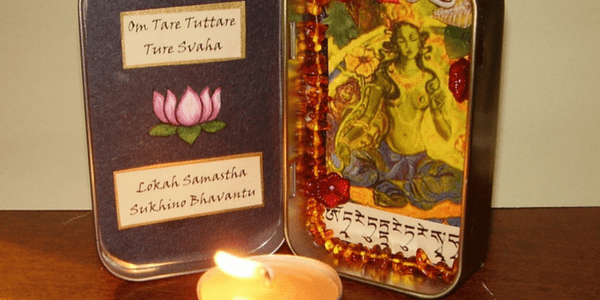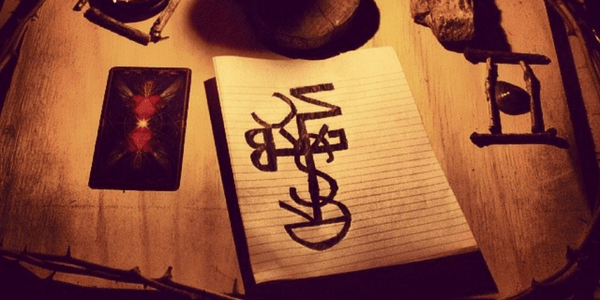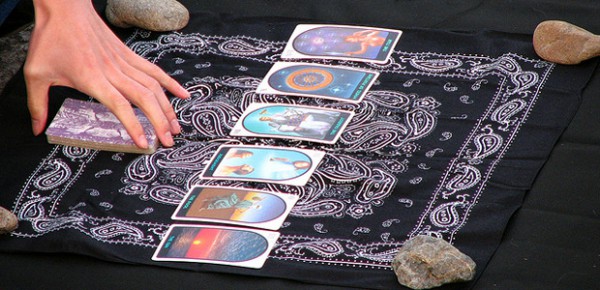 Are you a secret witch?
Are you a secret witch?
I’m obviously very public about my spiritual practice but this isn’t the case for everyone. For a variety of reasons, may people are “stuck in the broom closet” and have to keep their practice secret. This need for secrecy can be very hard to practice under, not only emotionally but also from a practical standpoint. Here are some tips to help people practice in secret.
Before we begin, however, I just want to address this issue as it is often seen in the overreaching culture and society of magick spaces, especially in the west. Too often I’ve seen groups that specifically exclude those that are secret about their practice, and this is not a fair thing to do.
Not everyone who is secretive is doing so out of shame or embarrassment. There are many people who are in living situations where it is not safe to be open about their beliefs. There are people who live in ultra conservative areas and it is not safe to be open. There are people who are still unsure of themselves and they are not ready to be open about their practices. There are people who just don’t think that it’s anyone else’s business about what they do and are not open about their practices.
These are all valid reasons not to share your practice and they should be respected, it is not for us to judge anyone else’s journey. We do not live their lives, we do not follow their paths.
Getting an education as a secret witch
Many new practitioners who aren’t sure where to start (but must stay secret) often are at a loss as to how to learn more about the work without exposing themselves. One of the simplest things to do is to read, but keeping an occult library would probably blow your cover.
The good news is that there are tonnes of resources available online. Not just blogs and websites (like the one you’re reading now!), but also a huge selection of books! Many of the older texts are available online through sites like JSTOR,1 the Internet Archive,2 and the Internet Sacred Text Archive.3 These are more academic in nature, but they offer very solid information on a variety of paths and histories for the person new to all of this.
Another option is to purchase ebooks for things that you are interested in learning about. Many of the larger publishers in the metaphysical realm offer their titles in ebook form that can easily be purchased from sites like Amazon of Google Books. These can be read on tablets or even just on your phone, and are a great way of keeping your little library safe from prying eyes.
Finally, don’t discount online groups and forums. These places usually have files that they share and people are always willing to help those who are looking for information. Not all groups are meant for everyone though, so try a bunch and see what fits!

Altar spaces and sacred spaces
One of the biggest issues for people who are practicing in secret is the altar. Regardless of which practices you follow, many of them call for the use of an altar and even if ultimately the practitioner moves away from such practices, many people just starting out wish to have one.
Simple altars generally include representations of the four elements, icons or representations of deities or our ancestors and at least a small space for offerings. These are just some basic staples. Representations can be pictures or even small jars filled with the elements along with candles or incense.
There are many options for building one for more discreet practice. One basic suggestion is to place the altar in a closet, if you at least have your own room, that way it will not be on display. Another option for a larger altar is to build it inside of a box or suitcase that can be hidden under the bed when not in use. This solution works very well for those who at least have their own bedroom to function in.
For people who do not have their own room, it is still possible to have an altar! Small altars made from small boxes, even mint tins, are very popular. By using smaller vials or relying on just pictures and drawings, you can make a simple, functional altar.
A final solution for those who absolutely cannot have a physical altar is to create a virtual one. Either by using elements you found on the web to create a photo collage, or setting up a temporary altar and snapping a photo. This isn’t the greatest option as altars should ideally be “living” spaces where you move, add, and change things as part of your practice, but for people in a tight spot, it is a solid choice.
Related: Creating your altar: A beginner’s guide, by Donyae Coles
Related: Portable shrines: You can take it with you, by Laura Perry

Making offerings in secret
If you do have to rely on a digital altar space or one that cannot be out in the open, making offerings can be a bit tricky. After all, you can’t just set a plate in front of your nana’s photo and call it a day! But don’t worry, there are many other ways to send your offerings.
The first is simple, although food and drink are some of the most basic offerings we make, you can also offer your prayers, the lighting of a candle or your own meditation as a form of vernation. This option works for honouring both gods and ancestors. They will understand your constraints as long as you are diligent in your work and honest with what you can give.
Another solution is to make your offerings at a place that is associated with them. For ancestors, a trip to their graves (if possible) is something that would not raise suspicion in most communities. Taking flowers once a week to a cemetery is a very commonplace activity and people wouldn’t bat an eye.
If you’re dealing with deities or other natural spirits, then you can simply go to places that are associated with them. This means, for example, that if you want to make an offering to Oshun4 (a very popular Orisha), you could go to a river and leave her offering for her. Or, if you were hoping to commune with Dionysus,5 hit up a wine bar. The key is to find the things which is associated with them, where their energy would gather and go there.
Get to know who you are worshipping and get creative! There are a million and one places where a deity’s energy might be felt outside of the obvious ones, like parks and streams. Think about what your chosen deity likes and go where you can find that thing!
In some locations, it is much easier to leave offerings than others. Obviously in a park or by a river, for example, it would be very easy to leave something (just make sure that whatever you are leaving will not harm the environment!), but in a shop or public place, it might be a bit harder to do so discreetly. In public places, you may only be able to offer a prayer or devotion to your deity but that is better than nothing at all.
Related: Working with multiple pantheons: A beginner’s guide, by Donyae Coles
Related: 5 ways to connect with nature as an urban Pagan, by Samantha Bell

Doing the work as a secret witch
The second hurdle for people who must keep their practice secret is actually doing the work of the craft. For people who practice forms of chaos magick or just general worship, they may not need to engage in any actual rituals or spells. For other paths, actually completing rituals and casting are important parts of their practice and many people who must do so in secret feel as if they aren’t really following their paths because they cannot do so.
Related: Top 5 chaos magick books, by Psyche
Although very blatant things like sigils scrawled on your walls, talismans around your neck, and iron cauldrons boiling over the fire may tip people off to what you’re doing, it is very possible to do work in secret. The first step is throwing out any preconceived notions of what the craft looks like. Forget about dancing naked in the moonlight, wearing pentagram everything, or swapping out your deodorant for a permeant aura of Nag Champa incense. None of those stereotypical things are needed to practice and you are more than welcome to do them later when you can be more open. For now, let’s concentrate on what you can do.
Ok, even though I just made a joke about it, the hidden practitioner can make great use of sigils and talismans as they can be hidden and their true purpose kept secret, easily. Sigils are very easy ways to do spell work.6 It is very easy to create them and if anyone asks what you’re doing, simply tell them you are doodling to relieve stress and clear your mind. To activate them, simply tear up the paper they’re written on and toss it. No one will question why you ripped up a scrap piece of paper.
You can also draw sigils on yourself in lotion and rub them into your skin for beauty, confidence, and protection. Zero evidence of the work you’ve done and can be applied daily.
Related: Fireclown’s sigilization basics for the confused, by Fireclown
Related: Sigils, servitors and godforms: Part I, by Marik
Related: Sigils, servitors and godforms: Part II, by Marik
Similarly, talismans can be worn as simple pieces of jewellery. Many of them feature signs, symbols, and images that are very easy to pass off as just indie fashion. The pentagram or ankh, two of the most famous Pagan symbols, likely will draw some stares and questions but wearing something lower key like an angel, a scarab, flowers or even a simple goddess can easily be passed off as fashion or a good luck charm. Another option is to use correspondence and instead focus on stones and crystals such as an onyx bracelet for protection.
Related: The High Magic of Talismans and Amulets, reviewed by Freeman Presson
Related: Crystals: How to buy your first one, by Donyae Coles
If you wish to work with ingredients to create mixtures to draw energy to you, then you don’t have to sneak to your local metaphysical shops or order things from online sellers. Most of my magickal supplies came right from my local grocer.
Performing cleansing rituals that add a bit of a punch to bath and mop water is very simple. Brew some basil and rosemary “tea” and add it to the water. If anyone asks, you can always say you read that it improves the cleaning power of soap “somewhere.” Both of these herbs have cleansing powers and will help draw away negativity. As will adding a pinch of salt. All of these are available in everyday stores.
Protection and uplifting work, such as bringing peace to the home, can be done quite discreetly through “kitchen witchery” by adding intent to the herbs and spices you use regularly. As you’re brewing tea, kneading dough, or just stirring soup, take a moment to focus your intentions. Want to use a herb for something but you don’t usually cook that type of food? Just expand your menu.
Even banishing work can be performed in the kitchen. A simple work that can be performed is to write the name of the person or thing you want banished from your life on a scrap of paper, focus on their removal from your life and burn the paper on the stove fire.
These are all very simple suggestions that don’t involve a great deal of supplies and the ones they do use are not at all hard to come by, nor would they be out of place in any home.
Related: A Kitchen Witch’s World of Magical Food, reviewed by Susan Starr
Related: Springtime kitchen witchery: 10 herbs for protection, peace, and luck, by Donyae Coles

Low key divination
Finally, there’s the act of divination. Many people who embrace this lifestyle practice some form of divination as a way to help guide them, commune with the higher and lower planes, practice meditation, or even see how spell work will go for them. The problem with most divination is that you need tools and these leave the secret witch open for discovery.
The easiest-to-hide form of divinatory tools is perhaps the pendulum. The types you can purchase from shops made from crystals, stones, and fine metals are lovely but you don’t need these to practice this art. You can make a pendulum from just about anything and a piece of string. A ring, a key, a nail, tied to a string and there you go! It’s also very easy to make a pendulum board or mat.
Draw a circle, write “yes” on the left and right points, “no” on the north and south and maybe on the points between. As you hold your pendulum it will swing towards one of these points. You can also read without such a board by asking the pendulum a question you know the answer to in order to prime it. Keep in mind which way it leans towards — that’s the “yes” direction for that reading.
Scyring can also be done with limited tools, however, it does take some alone time so this is only an option for people who are able to be alone and meditate comfortably. It can be done outside or even by staring at a screen, but if anyone will wonder why you’re staring at a screen for so long, it may not be the best option.
Tarot cards are the most popular option for divination but keeping a deck can be hard for people living in secret. There are online tarot decks available that can be used through apps, such as the Golden Thread Tarot7 (which is free), but this may not give people the full feeling. Learning about cartomancy, reading with standard playing cards — you can learn the techniques from Fortune-Telling by Cards by P.R.S. Foli,8 a book available online for free.
Related: Dowsing without a pendulum: Divination on demand, by Charlz dela Cruz
Related: Scrying: How to get started, by Donyae Coles

Standing in your power, even in secret
As I mentioned earlier, secret witches and people trapped in the broom closet get a lot of guff from those who have the privilege to be open about their practices. It’s hard when you feel like you can’t really be who you are and do the things that would fulfil you as a person.
These tips and tricks are meant to help you find ways to practice while keeping your mental and physical health safe from bullying and harm. Not everyone understands this lifestyle and some still outright fear it due to ignorance, however, don’t let that stop you from exploring, even if you have to do so in secret.
Image credits: Rudolf Vlček, dirrosa, Dianne Sylvan, becker.abigail, toseekwithin, MShades
- “JSTOR,” jstor.org, 2017. [↩]
- “Internet Archive: Digital Library Of Free Books, Movies, Music & Wayback Machine,” Archive.Org, 1996. [↩]
- “Internet Sacred Text Archive Home,” Sacred-Texts.Com, 2011. [↩]
- Bayyinha Jefferies, “Oshun | Yoruba Deity,” Encyclopedia Britannica, 2017. [↩]
- Michael Karas and Charilaos Megas, “Dionysus”, Greekmythology.Com, 1997. [↩]
- “Creation & Activation,” Sigil Daily, 2017. [↩]
- Tina Gong, “Golden Thread Tarot: Learn How to Read Tarot Cards Free, Get Tarot Readings, And Modern Tarot Deck”, Goldenthreadtarot.Com, 2017. [↩]
- P.R.S. Foli, “Fortune Telling By Cards Index,” Sacred-Texts.Com, 1915. [↩]








